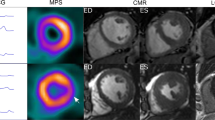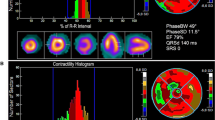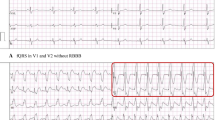Abstract
Objective
Paradoxical septal motion (PSM) can cause confusion in the assessment of ventricular function with scintigraphy even in the absence of ventricular septal damage and ischemia. Fragmented QRS (fQRS) is associated with various cardiac disorders. In this study, we aimed to determine the correlation between paradoxical septal motion and fQRS after coronary artery bypass grafting (CABG).
Methods
We retrospectively reviewed the hospital records showing scintigraphic images and electrocardiograms (ECG) of the patients who had undergone CABG. The patients were classified based on the evaluation of motion and thickening of the septal wall. The patients with regular thickening of the septal wall and abnormal motion were classified as PSM (+) group. The patients with normal motion and thickening of the septal wall were classified as PSM (−) group. fQRS complexes are defined as various RSR patterns either with or without Q-waves on a 12-lead resting ECG.
Results
PSM was found to be more common in fQRS patients (p < 0.001). PSM was seen in 91.4 % of cases with fQRS and in 79.8 % of cases without fQRS. No significant differences were found in the phase analysis parameters. A correlation was found between septal wall motion values and the presence of fQRS (r = 0.197, p = 0.012).
Conclusion
fQRS was associated with PSM. fQRS may cause PSM in patients with CABG without left bundle branch block due to a conduction defect. PSM and fQRS are predictive of cardiac mortality. Patients diagnosed with PSM and fQRS, should be monitored closely.


Similar content being viewed by others
References
Giubbini R, Rossini P, Bertagna F, Bosio G, Paghera B, Pizzocaro C, Canclini S, Terzi A, Germano G. Value of gated SPECT in the analysis of regional wall motion of the interventricular septum after coronary artery bypass grafting. Eur J Nucl Med Mol Imaging. 2004;31:1371–7.
AlJaroudi W, Alraies MC, Brunken R, Cerquiera M, Jaber WA. Paradoxical septal motion from prior coronary artery bypass graft surgery does not impact left ventricular mechanical dyssynchrony by gated myocardial perfusion imaging. J Nucl Cardiol. 2012;19:1190–7.
Reynolds HR, Tunick PA, Grossi EA, Dilmanian H, Colvin SB, Kronzon I. Paradoxical septal motion after cardiac surgery: a review of 3,292 cases. Clin Cardiol. 2007;30:621–3.
Swaminathan M, Morris RW, De Meyts DD, Podgoreanu MV, Jollis JG, Grocott HP, Milano CA, Newman MF, Mathew JP. Deterioration of regional wall motion immediately after coronary artery bypass graft surgery is associated with long-term major adverse cardiac events. Anesthesiology. 2007;107:739–45.
Hannan EL, Wu C, Bennett EV, Carlson RE, Culliford AT, Gold JP, Higgins RS, Isom OW, Smith CR, Jones RH. Risk stratification of in-hospital mortality for coronary artery bypass graft surgery. J Am Coll Cardiol. 2006;47:661–8.
Das MK, Zipes DP. Fragmented QRS: a predictor of mortality and sudden cardiac death. Heart Rhythm. 2009;6:8–14.
Femenía F, Arce M, Van Grieken J, Trucco E, Mont L, Abello M, et al. Fragmented QRS in hypertrophic obstructive cardiomyopathy (FHOCM) study investigators. Fragmented QRS as a predictor of arrhythmic events in patients with hypertrophic obstructive cardiomyopathy. J Interv Card Electrophysiol. 2013;38:159–65.
Pei J, Li N, Gao Y, Wang Z, Li X, Zhang Y, et al. The J wave and fragmented QRS complexes in inferior leads associated with sudden cardiac death in patients with chronic heart failure. Europace. 2012;14:1180–7.
Das MK, Michael MA, Suradi H, Peng J, Sinha A, Shen C, et al. Usefulness of fragmented QRS on a 12-lead electrocardiogram in acute coronary syndrome for predicting mortality. Am J Cardiol. 2009;104:1631–7.
Pietrasik G, Goldenberg I, Zdzienicka J, Moss AJ, Zareba W. Prognostic significance of fragmented QRS complex for predicting the risk of recurrent cardiac events in patients with Q-wave myocardial infarction. Am J Cardiol. 2007;100:583–6.
Wang J, Tang M, Mao KX, Chu JM, Hua W, Jia YH, et al. Idiopathic ventricular fibrillation with fragmented QRS complex and J wave in resting electrocardiogram. J Geriatr Cardiol. 2012;9:143–7.
Sharir T, Berman DS, Waechter PB, et al. Quantitative analysis of regional motion and thickening by gated myocardial perfusion SPECT: normal heterogeneity and criteria for abnormality. J Nucl Med. 2001;42:1630–8.
Nakata T, Katagiri Y, Odawara Y, et al. Two-dimensional and three-dimensional assessments of myocardial perfusion and function by using technetium-99 m sestamibi gated SPECT with a combination of count- and image-based techniques. J Nucl Cardiol. 2000;7:623–32.
Chua T, Kiat H, Germano G, et al. Gated technetium-99 m sestamibi for simultaneous assessment of stress myocardial perfusion, postexercise regional ventricular function and myocardial viability: correlation with echocardiography and rest thallium-201 scintigraphy. J Am Coll Cardiol. 1994;23:1107–14.
Henneman MM, Chen J, Ypenburg C, Dibbets P, Bleeker GB, Boersma E, et al. Phase analysis of gated myocardial perfusion single-photon emission computed tomography compared with tissue Doppler imaging for the assessment of left ventricular dyssynchrony. J Am Coll Cardiol. 2007;49:1708–14.
Chen J, Garcia EV, Folks RD, Cooke CD, Faber TL, Tauxe EL, et al. Onset of left ventricular mechanical contraction as deter-mined by phase analysis of ECG-gated myocardial perfusion SPECT imaging: development of a diagnostic tool for assessment of cardiac mechanical dyssynchrony. J Nucl Cardiol. 2005;12:687–95.
Ruberman W, Weinblatt E, Goldberg JD, Frank CW, Chaudhary BS, Shapiro S. Ventricular premature complexes and sudden death after myocardial infarction. Circulation. 1981;64:297–305.
Lesh MD, Spear JF, Simson MB. A computer model of the electrogram: what causes fractionation? J Electrocardiol. 1988;21:S69–73.
Başaran Y, Tigen K, Karaahmet T, Işıklar I, Çevik C, Gürel E, et al. Fragmented QRS complexes are associated with cardiac fibrosis and significant intraventricular systolic dyssynchrony in nonischemic dilated cardiomyopathy patients with a narrow QRS interval. Echocardiography. 2011;28:62–8.
Chatterjee S, Changawala N. Fragmented QRS complex: a novel marker of cardiovascular disease. Clin Cardiol. 2010;33:68–71.
Das MK, Khan B, Jacob S, Kumar A, Mahenthiran J. Significance of a fragmented QRS complex versus a Q wave in patients with coronary artery disease. Circulation. 2006;113:2495–501.
Ozdemir S, Yan YZ, Colkesen Y, Temiz A, Turker F, Akgoz S. Comparison of fragmented QRS and myocardial perfusion-gated SPECT findings. Nucl Med Commun. 2013;34(11):1107–15.
Lamba J, Redfearn DP, Michael KA, Simpson CS, Abdollah H, Baranchuk A. Radiofrequency catheter ablation for the treatment of idiopathic premature ventricular contractions originating from the right ventricular outflow tract: a systematic review and metaanalysis. Pacing Clin Electrophysiol. 2014;37:73–8.
Temiz A, Gazi E, Altun B, Güngör Ö, Barutçu A, Bekler A, Tan YZ, Yener AÜ, Saçar M, Çölkesen Y. Fragmented QRS is associated with frequency of premature ventricular contractions in patients without overt cardiac disease. Anadolu Kardiyol Derg. 2014;42(8):726–32. doi:10.5152/akd.2014.5467.
Author information
Authors and Affiliations
Corresponding author
Ethics declarations
Conflict of interest
The authors have no conflicts of interest to declare.
Funding
None.
Rights and permissions
About this article
Cite this article
Barutçu, A., Ozdemir, S., Tan, Y.Z. et al. Relationship between fragmented QRS and paradoxical septal motion in coronary artery bypass graft patients. Ann Nucl Med 29, 825–832 (2015). https://doi.org/10.1007/s12149-015-1016-0
Received:
Accepted:
Published:
Issue Date:
DOI: https://doi.org/10.1007/s12149-015-1016-0




